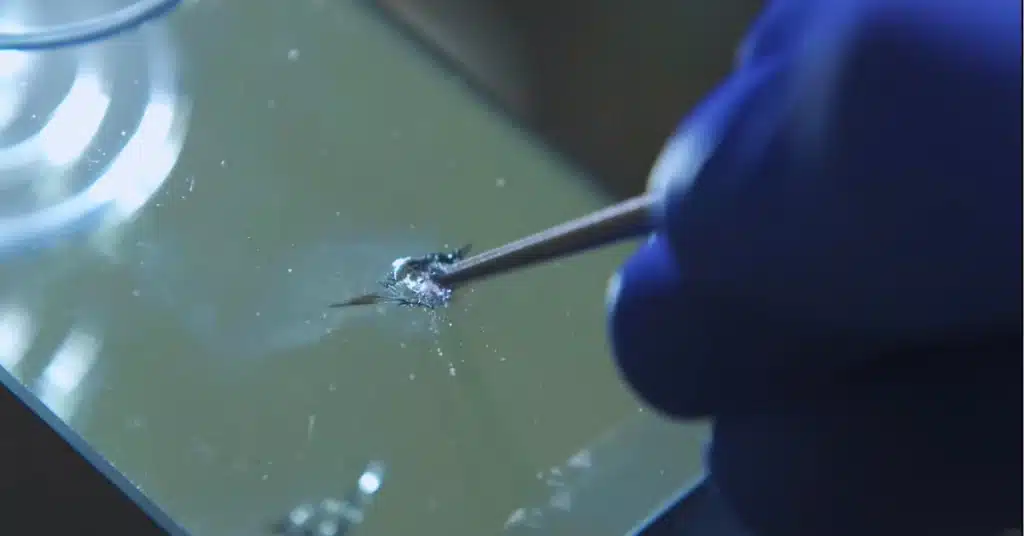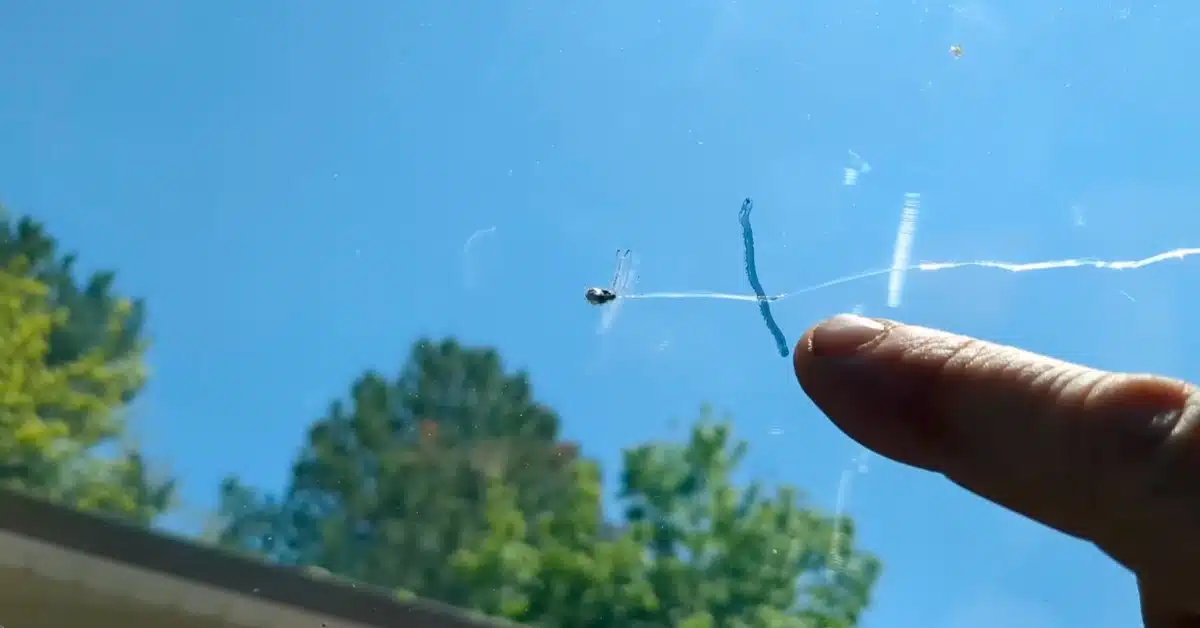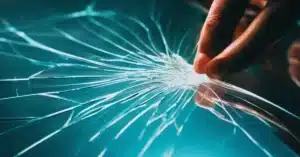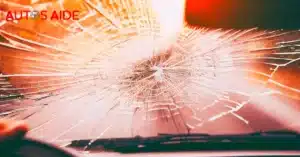Something is enchanting about the open road — the feeling of freedom, the joy of exploration.
But what happens when your journey is marred by the sudden appearance of a chip or crack on your windshield?
It’s a common issue many drivers face and can turn a pleasant drive into a worrisome ordeal.
It’s here that understanding the key differences between a “windshield chip vs. crack” becomes crucial to ensuring your safety.
Read More: How To Stop A Crack In Windshield From Spreading?
Windshield Chip vs. Crack: A Closer Look
To many, a chip and a crack might seem interchangeable, but they’re distinct types of damage in the world of auto glass.
A windshield chip is generally a small spot of damage where a piece of the glass has been removed, leaving behind a shallow pit or depression. Depending on the impact, chips can take various shapes, such as circular, star-shaped, or half-moon.
On the other hand, a windshield crack is a line of breakage that creeps across your windshield, extending from a single point.
Cracks can vary in length and direction and often grow larger if not addressed in a timely manner.

Read More: Can a 12-inch Crack in Windshield Be Repaired?
Identifying Types of Windshield Chips
Among windshield chips, certain types appear more frequently. Here’s a closer look:
Bullseye
True to its moniker, a bullseye chip looks remarkably similar to a bullseye target. It’s a circular damage area with a pit in the center, the point of impact. While this type of chip does not usually spread, it can weaken the overall structural integrity of the windshield.
Star
Star chips get their name from the star-like pattern they form on the windshield. Short cracks spread outward from the central point of impact, creating a shape reminiscent of a star. Star chips pose a higher risk of spreading if left untreated, mainly due to the multiple weak points.
Half-moon
Half-moon chips are semi-circular in shape and are often the result of an oblique impact. They typically don’t spread as quickly as star chips but need immediate attention to prevent further damage.
Decoding Types of Windshield Cracks
Though uniformly unsettling to any driver, windshield cracks come in various forms.
Each type manifests differently and poses unique challenges and risks. Understanding the difference can help guide your response and action.
Stress Crack
Stress cracks stand out because they can form without any physical impact on the windshield. The villain here is usually a sudden or extreme temperature change that causes the glass to expand or contract rapidly.
Imagine blasting the heat in your car during winter to ward off the cold or turning up the air conditioning in the summer. This can trigger a stress crack which often begins at the edge of the windshield.
Initially, it might look like a small squiggle, but left unattended, and it can grow, snaking its way across your entire windshield.
Edge Crack
As the name suggests, edge cracks start at the perimeter of the windshield, typically within 2 inches of the edge.
What’s distinctive about them is their sudden appearance and their length. One moment your windshield is clear; the next, there’s a crack from 10 to 12 inches long.
The insidious nature of edge cracks often necessitates an immediate windshield replacement due to their size and the structural weakness they introduce.
Floater Crack
Unlike edge cracks, floater cracks occur towards the center of the windshield. They are termed ‘floaters’ because they are located at least 2 inches from the edge, seemingly floating in the central field of view.
Their position can severely obstruct the driver’s vision, which makes them a substantial safety risk. In most cases, if the floater crack is longer than six inches, the windshield replacement is the safest option.
Read More: Do You Need A Special Windshield For Heads Up Display?
Common Culprits: Causes of Windshield Chips and Cracks
The causes of windshield chips and cracks are as diverse as the forms they take. Understanding the reasons behind such damage can help you take proactive measures to prevent them, thereby extending the life of your windshield.
Road Debris: One of the most common culprits is debris on the road. Small rocks, pebbles, or even metal fragments can get kicked up by the vehicle tires in front of you or oncoming traffic.
When these projectiles hit your windshield at high speed, they can cause chips or cracks.
Severe Weather: Mother Nature can be a formidable adversary to your windshield. Hail is a known offender, with hard ice pellets pelting down on your car and potentially causing chips or cracks.
Heavy winds, too, can cause damage by blowing around debris with enough force to impact your windshield.
Temperature Fluctuations: Glass expands in heat and contracts in the cold.
If your windshield experiences extreme temperature changes too quickly — like blasting the AC in the car on a hot day or using the defroster on full power during a frosty morning — it can cause stress cracks to form.
Structural Issues or Manufacturing Defects: While less common, structural issues with the car or defects from the manufacturing process can also cause windshield damage.
For instance, if the windshield isn’t installed correctly or there’s an issue with the car’s design, it can put undue pressure on the glass, leading to chips or cracks.
Accidents or Vandalism: Whether it’s a minor fender bender or a significant collision, accidents can lead to windshield damage. Vandalism is another unfortunate cause, where intentional acts can result in chips or cracks.
While not all causes of windshield chips and cracks are preventable, being aware of these common culprits can help you take steps to minimize the risks.
Safety Implications: The Role of the Windshield
The windshield of a vehicle is not just a window to the world; it’s a critical component in maintaining vehicle safety. It has roles that extend far beyond shielding you from wind and weather. Understanding these can underscore the importance of addressing windshield chips and cracks promptly.
Structural Integrity: The windshield contributes significantly to the structural integrity of your vehicle.
A sturdy windshield can prevent the roof from caving in a rollover accident, protecting the occupants from serious injury.
Airbag Deployment: In a collision, the windshield is a backstop to deploy passenger-side airbags. When the airbag inflates, it expands toward the windshield and bounces back toward the passenger.
A compromised windshield may not withstand the force of the airbag, leading to less effective airbag deployment.
Passenger Retention: During a high-speed crash or collision, it’s crucial to keep the vehicle’s occupants within the confines of the car.
A fully intact windshield can be a barrier to prevent passengers from being ejected out of the vehicle, significantly reducing the risk of serious injuries or fatalities.
Clear Visibility: At its most basic, a windshield provides the driver with a clear view of the road and the surroundings.
A chip or crack can obscure this view, leading to potential hazards going unnoticed.
Given these safety implications, even minor windshield damage should never be taken lightly. A chip or crack weakens the windshield, compromises its role in vehicle safety, and demands immediate professional attention.
Repair or Replacement: Making the Right Decision
Addressing windshield damage swiftly is crucial, but knowing whether to repair or replace, it can be a problem. The decision depends on several factors, each contributing to the overall safety of your vehicle.
Size and Type of Damage: As a general rule, smaller chips and cracks can often be repaired. Chips smaller than a quarter and cracks less than three inches long are usually repairable.
But certain types of damage, like deep chips or complex cracks, may be beyond the scope of repair.
Location of Damage: The position of the chip or crack plays a significant role in determining the best course of action.
Damage directly in the driver’s line of sight can distort vision, even after a repair, and thus often warrants a replacement.
Similarly, cracks near the edge of the windshield tend to spread quickly and can undermine the windshield’s structural integrity, making replacement a safer option.
The severity of Damage: Sometimes, a windshield might suffer multiple chips and cracks. The repair might not restore the windshield’s integrity in such cases, and replacement becomes the safer choice.
It’s important to consult with auto glass professionals who can evaluate these factors and guide you in making the right decision.
They have the expertise to assess the damage and suggest the safest, most effective solution, whether repair or replacement.
Opting for the right fix ensures your safety and maintains the durability and performance of your windshield in the long run.
Shield Your Shield: Preventing Windshield Damage
While predicting or preventing every instance of windshield damage is impossible, understanding potential causes and practicing safe driving can go a long way in minimizing risks. Here are some measures you can take to shield your shield.
Maintain a Safe Distance: One of the simplest ways to prevent windshield damage is to avoid tailgating. Keep a safe distance from the vehicle in front, especially on highways or gravel roads, to prevent flying debris from impacting your windshield.
Regular Vehicle Maintenance: A well-maintained vehicle can mitigate some risks of windshield damage. Regular checks allow you to spot minor chips before they turn into bigger cracks. Fixing such small damages promptly can save your windshield and your wallet.
Avoid Extreme Temperature Changes: As mentioned earlier, sudden temperature changes can lead to stress cracks in your windshield. Avoid blasting your AC or heat when the outdoor temperatures are extremely high or low.
Also, try to park in shaded or covered areas when it’s hot or in enclosed areas during cold weather to minimize temperature fluctuations.
Safe Parking: Mindful parking can also help protect your windshield. Try to park away from areas where your car might be at risk from falling branches, construction debris, or even mis-hit baseballs from a nearby field.
Quality Windshield Wipers: Old or worn-out wipers can cause scratches on your windshield, eventually turning into chips or cracks. Ensuring you have high-quality wipers and replacing them regularly can help prevent this.
By practicing these preventive measures, you can protect your windshield from unnecessary damage, prolong its lifespan, and maintain safe and clear visibility on the road. It’s about being proactive, saving time, money, and life.
Andy’s Opinion
As we journey through the “windshield chip vs. crack” narrative, it’s clear that any windshield damage is more than just a cosmetic concern.
It’s a matter of safety, requiring timely attention and treatment. Identifying and addressing windshield damage early can ensure a safer journey, preserving the joy and freedom that the open road brings.
Can a windshield chip turn into a crack?
Yes, a windshield chip can certainly turn into a crack. Factors like temperature changes, rough roads, or simply driving can cause a chip to expand into a crack. That’s why it’s crucial to repair chips promptly to prevent further damage.
Is it safe to drive with a chip in your windshield?
Driving with a chip in your windshield risks safety and visibility. It’s advisable to have chips evaluated and repaired promptly by a professional.
How bad is a small chip in windshield?
While a small chip in a windshield may seem insignificant, it shouldn’t be underestimated. Even a small chip can have implications for the safety and integrity of your windshield.
Firstly, a chip weakens the structural strength of the glass, making it more susceptible to further damage. Factors such as temperature changes, vibrations from driving, or impact can cause the chip to expand and develop into a crack.
Secondly, a small chip can obstruct the driver’s view, especially if it’s in the line of sight. This compromises visibility and can be a distraction or hazard while driving.
Furthermore, if left unaddressed, a small chip can accumulate dirt and moisture over time, making it more challenging to repair and potentially requiring a full windshield replacement.
It’s essential to treat even small chips seriously and have them evaluated and repaired by a professional. Timely action can prevent further damage and ensure your windshield’s continued safety and longevity.





